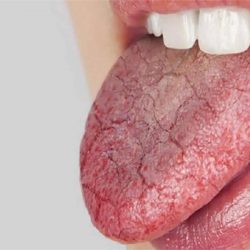The thyroid is an endocrine (or hormonal) gland, located against the esophagus and which is schematically shaped like a bow tie. It is essentially made up of vesicles with walls made up of a single layer of cells, and which contain the colloid, mainly made up of thyroglobulin. The two hormones secreted by the thyroid gland are triiodothyronine (T3) and tetraiodothyronine (T4 or thyroxine) which play a determining role in cell metabolism and their production of energy (in the form of ATP), under the dependence of TSH (Thyroid Stimulating Hormon).
Remember that the thyroid gland, located in the anterior part of the neck, is however composed of 2 lobes connected by an isthmus. It secretes hormones essential for bone growth, mental development, the transformation of lipids and sugars.
Hyperthyroidism
It is an hyperfunction of the thyroid gland which usually appears between the ages of 20 and 40. It affects 8 women for 1 man.
Its main causes are diverse, they can be due to Graves’ disease (or Graves disease), in 70 to 85% of cases (autoimmune disease in which antibodies will excessively stimulate the thyroid), they may also be due to the presence of toxic thyroid nodules, inflammation of the thyroid, certain drugs rich in iodine or a pituitary gland disorder.
Naturopathic advice in case of diagnosed hyperthyroidism:
- Rest needed
- Avoid stimulants especially at the end of the day (tea, coffee)
- Eat protein with every meal
- Avoid the consumption of foods rich in iodine (seafood, seaweed, sushi)
What plants for hyperthyroidism ?
-
Watercress:
This underwater plant inhibits the uptake of iodine in the thyroid by decomposition products of glucosinolates (like all Brassicaceae).
This herb is popular for promoting immunity, which is part of why it’s great for better thyroid health. It is best for those with an overactive thyroid and you should focus on using the root of the plant. You can use the roots to make an infusion by soaking the roots in boiling water.
-
Lycope:
This perennial herb, called “wolf’s foot”, blocks the production of thyroid hormone T4.
-
Chinese cinnamon, ginger and ginseng:
In particular, they can naturally regulate the thyroid.
Hypothyroidism
It is characterized by insufficient hormonal secretion of the thyroid gland.
Its main causes can be autoimmune (Hashimoto’s thyroiditis), iatrogenic (following treatment with radioactive iodine to destroy the thyroid gland or following the taking of certain drugs (amiodarone) or even due to congenital hypothyroidism, to a pathology of the pituitary or even a hereditary predisposition.
Naturopathic advice in case of diagnosed hypothyroidism:
- Eat a balanced diet low in cholesterol (avoid organ meats, eggs, butter)
- Promote a diet rich in fiber, green vegetables, cereals to avoid constipation
- To drink a lot of water
- Favor foods rich in iodine (such as wakame for example)
Which plants for hypothyroidism ?
-
The oats :
This cereal is indicated in thyroid insufficiency, it naturally stimulates the thyroid gland.
-
The guggul:
This plant is generally indicated in cases of hypothyroidism. The guggulsterones would act by stimulating the thyroid, would activate the membrane receptors of fixation of LDH at the hepatic level, hence an increase in their metabolism. Guggul regulates the levels of T3 and T4 hormones.
-
The bladderwrack :
This herb has a lot of potential for those experiencing thyroid insufficiency. This is because it has a high iodine content and iodine is one of the most important nutrients for your thyroid.
-
The flax seeds :
People who have hypothyroidism can help increase their thyroid hormone levels by consuming this herb daily. What’s great about this herb is that you only need about a tablespoon every day to reap the full benefits. You can add mixed flax seeds to a smoothie or with your food, making it a very convenient choice. Flax seeds should always be mixed just before consuming them because mold grows quickly, even if it is not visible.
If you have hypothyroidism that causes you to feel tired, this herb may help. Besides helping to promote the regulation of thyroid hormones to improve your thyroid, it also gives you a slight boost of energy. As a bonus, this plant contains what’s called glycyrrhetinic acid. This may offer some potential to inhibit the growth of certain types of thyroid cancer cells.
This herb is popular for women’s health, but it is also very beneficial for the thyroid. Besides being an aid for hypothyroidism as a whole, it can also help with the symptoms of this condition, such as reducing hair loss and heavy periods. It is often recommended to put it in a hot drink to fully enjoy it.
-
The ashwagandha :
Also known as “Indian ginseng ”. This plant promotes the production of T4 hormones, a virtue proven by clinical tests.
Hypothyroidism and homeopathy:
These drugs are generally prescribed in medium to high dilution and in spaced doses.
In subjects whose metabolism is slowed down , with alternating dermatological and digestive disorders . Graphites reproduces the picture of thyroid and gonadal insufficiency .
Good responders are pale, fat, cautious , shy, and emotional . They tend to constipation and venous disorders . The skin is dry , the edemas are marked , especially on the eyelids , and on the anterior face of the leg (classic pretibial edema).
In women , the periods are spaced or even absent , the libido is collapsed in both sexes.
This medication can correspond to fatty, slow, shy, fearful subjects, prone to school difficulties in children, and to early intellectual and motor slowing down in adults.
Tendency to high blood pressure .
They may be supplemented, according to the table by :
-
Alumina :
For sad and agitated subjects for whom time passes too slowly, impressionable and with dryness of the skin and mucous membranes . With spider web feel on the face . The skin retains the fold when pinched . Brittle nails and hair . Appearance of premature aging .
With marked tendency to edemas, fatigue, chilliness .
Can complement Graphites in women.
-
Silicea :
With extreme reluctance and fatigability .
-
Thuja :
In a fatty and infiltrated subject , especially at the level of the hips and the pelvis , with cellulite in ” saddlebags “. Indicated in addition to previous strains when edema takes this form.
Conclusion :
However, all these natural treatments are not exempt from medical advice. They make it possible to avoid Levothyrox in the event of mild disorders. If, however, the problems persist, your thyroid will need to be regulated in a more ” artificial ” way and you will not be able to escape it.
However, plants can help you withstand some harmful side effects of the drug: ask your doctor or naturopath for any joint use.







